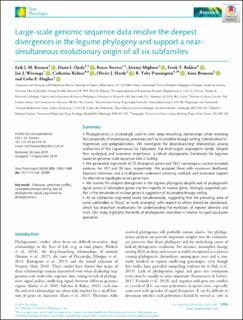| dc.contributor.author | Koenen, Erik J. M. | |
| dc.contributor.author | Alayon, Dario Isidro Ojeda | |
| dc.contributor.author | Steeves, Royce | |
| dc.contributor.author | Migliore, Jérémy | |
| dc.contributor.author | Bakker, Freek T. | |
| dc.contributor.author | Wieringa, Jan J. | |
| dc.contributor.author | Kidner, Catherine | |
| dc.contributor.author | Hardy, Olivier J. | |
| dc.contributor.author | Pennington, R. Toby | |
| dc.contributor.author | Bruneau, Anne | |
| dc.contributor.author | Hughes, Colin E. | |
| dc.date.accessioned | 2020-11-18T08:41:12Z | |
| dc.date.available | 2020-11-18T08:41:12Z | |
| dc.date.created | 2020-09-21T13:39:17Z | |
| dc.date.issued | 2019-10-30 | |
| dc.identifier.citation | New Phytologist. 2020, 225 (3), 1355-1369. | en_US |
| dc.identifier.issn | 0028-646X | |
| dc.identifier.uri | https://hdl.handle.net/11250/2688371 | |
| dc.description.abstract | Phylogenomics is increasingly used to infer deep‐branching relationships while revealing the complexity of evolutionary processes such as incomplete lineage sorting, hybridization/introgression and polyploidization. We investigate the deep‐branching relationships among subfamilies of the Leguminosae (or Fabaceae), the third largest angiosperm family. Despite their ecological and economic importance, a robust phylogenetic framework for legumes based on genome‐scale sequence data is lacking. We generated alignments of 72 chloroplast genes and 7621 homologous nuclear‐encoded proteins, for 157 and 76 taxa, respectively. We analysed these with maximum likelihood, Bayesian inference, and a multispecies coalescent summary method, and evaluated support for alternative topologies across gene trees. We resolve the deepest divergences in the legume phylogeny despite lack of phylogenetic signal across all chloroplast genes and the majority of nuclear genes. Strongly supported conflict in the remainder of nuclear genes is suggestive of incomplete lineage sorting. All six subfamilies originated nearly simultaneously, suggesting that the prevailing view of some subfamilies as ‘basal’ or ‘early‐diverging’ with respect to others should be abandoned, which has important implications for understanding the evolution of legume diversity and traits. Our study highlights the limits of phylogenetic resolution in relation to rapid successive speciation. | en_US |
| dc.language.iso | eng | en_US |
| dc.publisher | New Phytologist Trust | en_US |
| dc.rights | Navngivelse-Ikkekommersiell 4.0 Internasjonal | * |
| dc.rights.uri | http://creativecommons.org/licenses/by-nc/4.0/deed.no | * |
| dc.title | Large-scale genomic sequence data resolve the deepest divergences in the legume phylogeny and support a near-simultaneous evolutionary origin of all six subfamilies | en_US |
| dc.type | Peer reviewed | en_US |
| dc.type | Journal article | en_US |
| dc.description.version | publishedVersion | en_US |
| dc.rights.holder | © 2019 The Authors. | en_US |
| dc.source.pagenumber | 1355-1369 | en_US |
| dc.source.volume | 225 | en_US |
| dc.source.journal | New Phytologist | en_US |
| dc.source.issue | 3 | en_US |
| dc.identifier.doi | 10.1111/nph.16290 | |
| dc.identifier.cristin | 1831680 | |
| cristin.ispublished | true | |
| cristin.fulltext | original | |
| cristin.qualitycode | 2 | |

